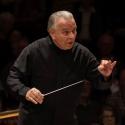 Mahler: Symphony No. 4 Turku Philharmonic Orchestra/Leif Segerstam, with Essi Luttinen (mezzo-soprano) (Alba)
Mahler: Symphony No. 4 Turku Philharmonic Orchestra/Leif Segerstam, with Essi Luttinen (mezzo-soprano) (Alba)
Leif Segerstam can be a maddeningly inconsistent conductor, a musician whose recordings can frustrate as much as they inspire. He’s recorded Mahler 4 before, unremarkably, with Danish forces on Chandos, so it’s good to report that this new Finnish version is a zinger. The Turku Philharmonic’s lean, clear sound suits this transparently scored symphony especially well, though there’s no lack of weight in the bigger climaxes. Intermittent dark clouds may threaten the symphony’s serene surface, but they don’t need overemphasis, and Segerstam’s wide-eyed delight is just what we need at the moment. Mahler isn’t all Sturm und Drang. Several passages in the first movement are genuinely funny here, the principal clarinet and bassoon deserving shout-outs. Flutes sound like penny whistles when they’re singing out their big tune seven minutes in, and the calmness, the peace which Segerstam conjures just before the first movement’s cheery coda is magical.
That sets a pattern for what follows, with a pungent scordatura violin solo in the scherzo and a dreamy trio. The booklet lists Segerstam’s timing for the third movement at 30 minutes, but that’s thankfully a typo; at 22 minutes he’s just fine. You’ll be pleasantly surprised by the wildness of the big eruption near the end, but that’s surely what Mahler wanted, and the ethereal music which follows is superbly handled. Mezzo-soprano Essi Luttinen’s darker tone may not be to all tastes in the vocal finale, but there’s no trace of archness, Segerstam bringing out the charm in Mahler’s instrumental writing. The close is blissful. Unexpectedly excellent – if you love this symphony, you need to hear this disc.
 Vaughan Williams: Symphony No. 5, Finzi: Clarinet Concerto Philharmonia Orchestra/Michael Collins (clarinet & conductor) (BIS)
Vaughan Williams: Symphony No. 5, Finzi: Clarinet Concerto Philharmonia Orchestra/Michael Collins (clarinet & conductor) (BIS)
Sir Simon Rattle’s recent, distanced Proms performance of Vaughan Williams’ 5th Symphony usefully raised the profile of this fascinating work, Rattle’s pre-concert appearances on C4 News and the Today Programme accompanied by rehearsal snippets. There’s an excellent 2012 Prom still available on iPlayer, Andrew Manze and the BBC Scottish SO surrounding the 5th with the symphonies which preceded and followed it. Nos. 4 and 6 have more violence, but there’s still a lot of ambiguity and unease in No. 5, exactly as you’d expect from a work premiered in 1943. My go-to recordings come from non-British conductors, Andre Previn and Gennady Rozhdestvensky among my favourites. Here’s clarinettist Michael Collins, securing radiant string playing from an on-form Philharmonia. The unrest is there from the outset, the strings’ low C clashing with the horn call, the dotted rhythms always dragging the music back. Collins’ scherzo plays out like a cousin to Holst’s Mercury, with fabulous muted strings and a startling trombone entry near the close. All lovely, as is the “Romanza”. You’d expect a clarinettist to give due prominence to the wind writing, the Philharmonia’s cor anglais up there with the best on disc. The finale’s first half never quite convinces me, though I love that bright D major trombone triad three and a half minutes in. The reprise of the symphony’s opening motif must be a nod to Daphnis and Chloe, and there’s more exquisite playing in the final minutes.
Finzi’s Clarinet Concerto makes for an appealing coupling. I’d not previously noticed how inventive the tutti string writing is, with hints of the Tallis Fantasia and Tippett’s Double Concerto. The huge slow movement flows as if it was nailed in a single take, and Collins is good at highlighting the wistful introspection just below the finale’s surface. Beautiful, heartfelt performances, in immaculate sound – more please.
 Sandbox Percussion: And That One Too (Coviello Classics)
Sandbox Percussion: And That One Too (Coviello Classics)
There’s a lot of lush string writing in Mahler and Vaughan Williams. Both composers are wonderful, but a third romantic orchestral disc might have tipped me over the edge this week. So it was a relief to dive into this debut disc from the New York quartet Sandbox Percussion, an album of bright, brittle and joyous new music. Percussion repertoire isn’t just about rhythm, several of the tracks here demonstrating the range of colours you can get when four smart musicians hit interesting stuff. I’m a sucker for esoteric instrumentation, and that the version of Andy Akiho’s Haiku 2 played here includes pipes, wooden slats and scrap metal makes it all the more appealing. It’s barely three minutes long, its groups of semiquavers ordered in 5-7-5 patterns opening on tuned ceramic bowls, the players shifting to untuned instruments when they repeat their patterns. Vibrant pentatonic chimes fade out imperceptibly, until we get “a dense hocket” of untuned sound. The four movements of David Crowell’s Music for Percussion Quartet suggest, variously, busy urban life and static peace, the quieter movements especially striking. Listen carefully and you’ll hear the composer’s guitar in the mix.
A multi-tracked Amy Beth Kirsten sings, breathes and speaks the three vocal parts to her she is a myth, drawing from Don Quixote and the 17th century poet Luis de Góngora, the percussive shakes, rattles and clicks in an accompanying role. And not only that one but that one & that too by Thomas Kotcheff was inspired by the contents of Sandbox’s shelves and the personalities of the four musicians. Unsung wooden sound makers get a chance to shine in the first section, followed by a showcase for drums and a glittering, melodic study for pitched metal instruments. Entertainment and musical substance in a handy package, and the recorded sound has incredible presence.














Add comment